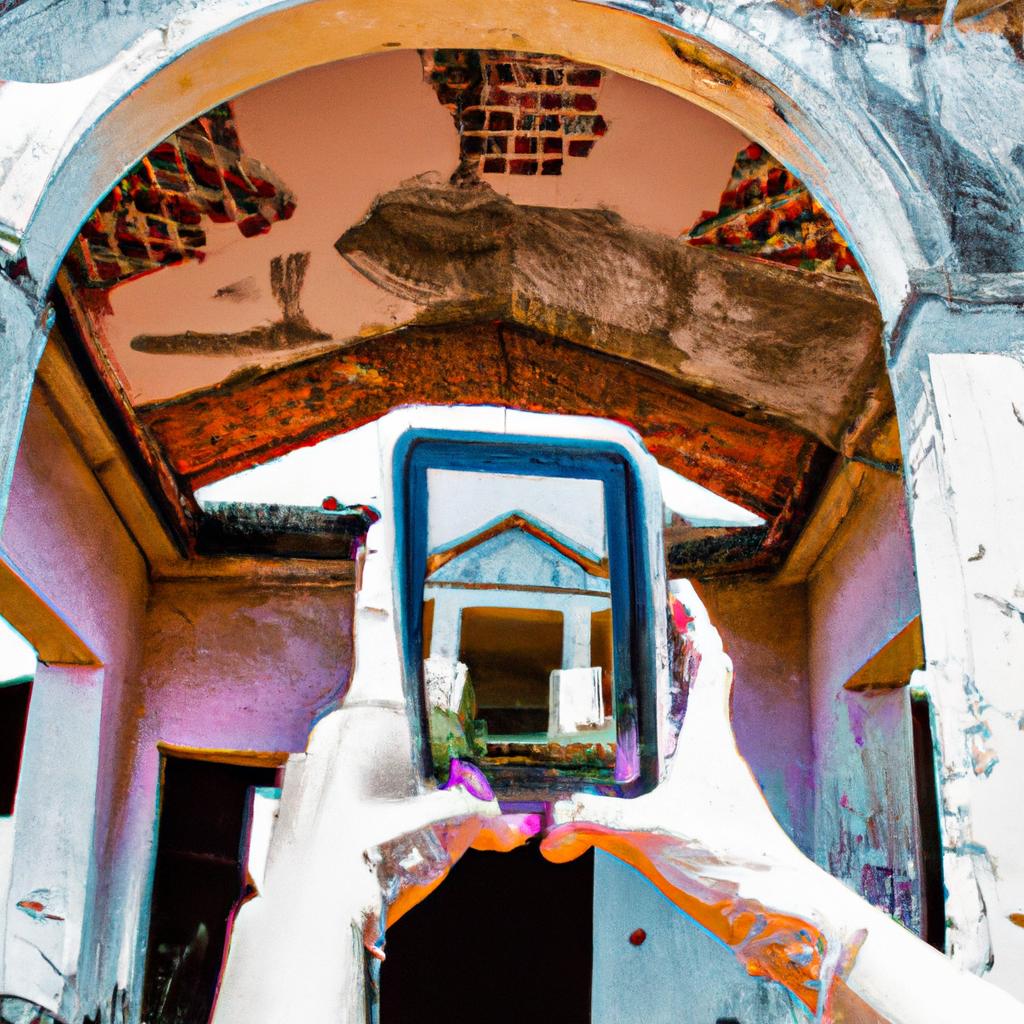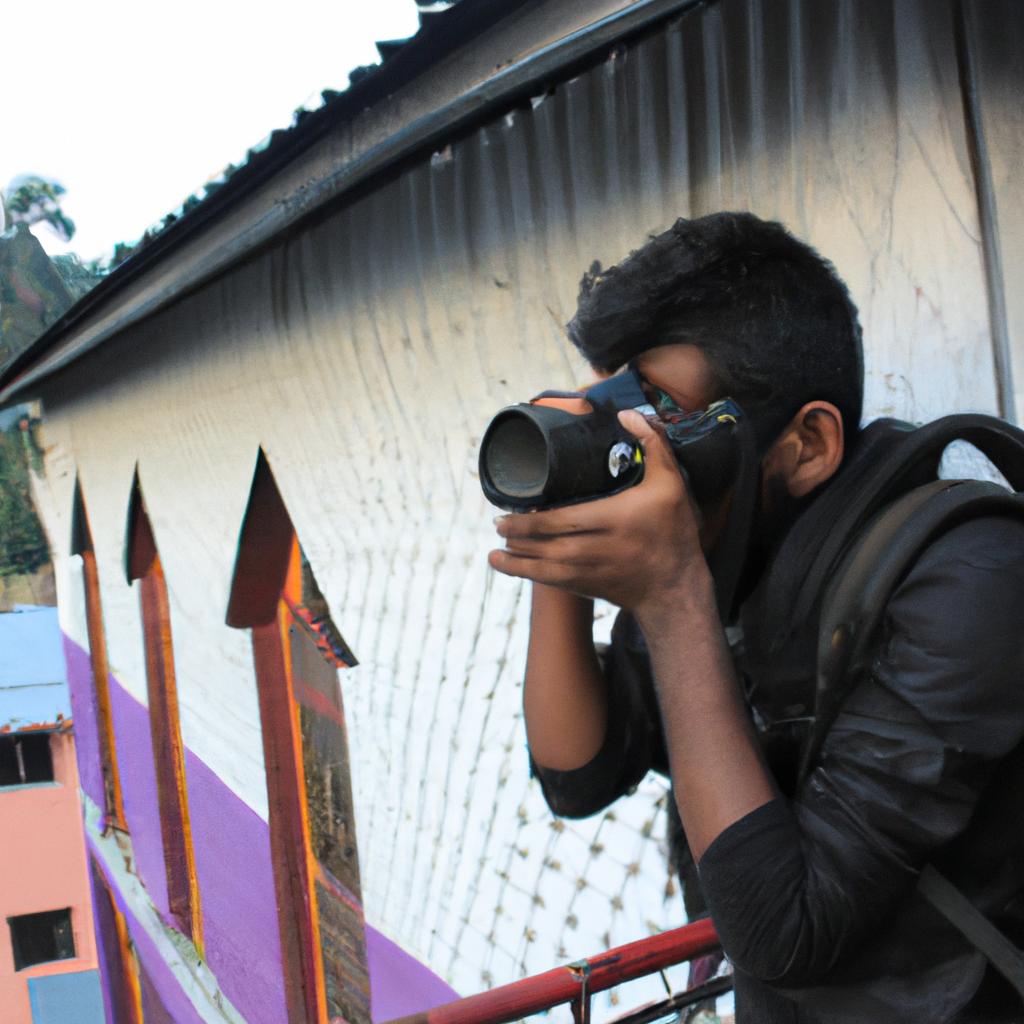Landscape photography is a captivating art form that captures the beauty and essence of the natural world. With its ability to evoke emotions, tell stories, and convey a sense of tranquility or awe-inspiring grandeur, landscape photography has become an important genre in both the art and photography worlds. For instance, consider the work of renowned photographer Ansel Adams who dedicated his career to capturing the breathtaking landscapes of Yosemite National Park. Through his black-and-white images, Adams not only showcased the majesty of nature but also highlighted how human interaction with these landscapes can shape our perception of them.
In order to create compelling and visually striking landscape photographs, understanding the aesthetics and techniques unique to this genre is essential. From composition and lighting to post-processing methods, each aspect plays a crucial role in creating impactful imagery. Furthermore, knowledge about different artistic styles within landscape photography allows photographers to experiment with various approaches such as minimalism or impressionism, adding depth and diversity to their portfolios. By delving into the context of arts and photography, we can explore how historical movements like Romanticism or Realism have influenced contemporary landscape photography practices today. This article aims to provide a comprehensive overview of the aesthetics and techniques specific to landscape photography within the broader realm of arts and photography while highlighting the importance of connecting with the natural world and preserving it for future generations.
Landscape photography relies heavily on composition to create visually appealing images. The rule of thirds, leading lines, and framing are all techniques that can be employed to guide the viewer’s eye through the photograph and create a sense of balance and harmony. Additionally, understanding how to use foreground elements to add depth and scale to the image is crucial in capturing the vastness of landscapes.
Lighting is another critical aspect in landscape photography. The quality and direction of light can dramatically impact the mood and atmosphere of a photograph. Golden hour, which refers to the period shortly after sunrise or before sunset when the sun is low in the sky, often provides soft and warm light that enhances the colors and textures of landscapes. On the other hand, dramatic lighting conditions such as stormy skies or harsh sunlight can also create captivating images with strong contrasts.
Post-processing plays an important role in landscape photography as well. Editing software allows photographers to enhance colors, adjust exposure, and fine-tune details to achieve their desired look. However, it is important to strike a balance between enhancing the photograph’s natural beauty and creating an overly manipulated image.
In terms of artistic styles within landscape photography, minimalism focuses on simplicity and reducing distractions within the frame. By removing unnecessary elements, minimalist photographs often evoke a sense of calmness or serenity. Impressionism, inspired by painting techniques from 19th-century artists like Monet or Renoir, aims to capture fleeting moments by using blurred brushstrokes or intentional camera movement. These techniques result in dreamlike or ethereal images that convey emotions rather than precise details.
Understanding historical movements like Romanticism or Realism can provide valuable insights into landscape photography practices today. Romanticism emphasized emotional expression and awe for nature’s grandeur while Realism sought to depict ordinary life without idealization. Contemporary landscape photographers draw inspiration from these movements by exploring themes of environmental conservation, human impact on nature, or the sublime beauty found in everyday landscapes.
In conclusion, landscape photography is a unique and captivating art form that requires a deep appreciation for nature and understanding of aesthetic principles. By mastering composition, lighting, post-processing techniques, and exploring different artistic styles, photographers can create impactful images that evoke emotions and tell stories. Moreover, by connecting with the broader tradition of arts and photography, landscape photographers can contribute to the ongoing dialogue about our relationship with the natural world.
The Importance of Composition in Landscape Photography
When it comes to landscape photography, composition plays a pivotal role in capturing captivating and visually appealing images. By carefully arranging the elements within the frame, photographers can guide the viewer’s eye and create a sense of balance, harmony, and visual interest. For instance, consider a hypothetical scenario where a photographer captures an image of a breathtaking sunset over rolling hills. Through effective composition techniques such as leading lines or the rule of thirds, they are able to emphasize the beauty of both the sky and land, creating a compelling visual narrative.
To understand why composition is crucial in landscape photography, let us explore four key reasons:
-
Enhancing Visual Impact: A well-composed photograph grabs attention immediately by presenting a strong focal point or subject that draws viewers into the scene. This could be an interesting rock formation, a solitary tree against an open field, or even contrasting colors that add depth and vibrancy to the image.
-
Conveying Mood and Emotion: Composition choices can evoke specific emotions from viewers. By framing scenes with different angles or perspectives, photographers have the power to communicate tranquility, awe, loneliness, or any other desired emotional response. The choice of foreground elements also influences how viewers engage emotionally with the image.
-
Creating Depth and Dimension: Skillful use of compositional techniques like layering elements at various distances from the camera helps create depth in photographs. This three-dimensional effect adds realism and allows viewers to feel immersed in the scene.
-
Guiding Viewer’s Eye: Composition controls how viewers navigate through an image by using leading lines or points of interest strategically placed within the frame. These visual cues lead their gaze along intended paths while ensuring all important elements receive proper attention.
In order to fully grasp these concepts related to composition in landscape photography, it is essential for photographers to develop a solid understanding of light and its impact on their work—a topic we will delve into in the subsequent section. By skillfully manipulating light and incorporating it into their compositions, photographers can elevate their images to new levels of visual excellence.
Understanding Light and its Impact on Landscape Photography
Landscape photography is a genre that requires careful consideration of various elements to create visually appealing and impactful images. In the previous section, we discussed the significance of composition in landscape photography. Now, let us delve into another crucial aspect: understanding light and its profound impact on this art form.
To illustrate the importance of light in landscape photography, consider a hypothetical scenario where a photographer captures an image of a serene beach during sunset. The warm golden hues reflecting off the calm waters produce a mesmerizing effect, evoking feelings of tranquility and serenity in viewers. This example highlights how lighting conditions can greatly influence the mood and atmosphere conveyed by a photograph.
When it comes to capturing landscapes, photographers must be mindful of different lighting situations and adapt their techniques accordingly. Here are some key considerations:
- Golden Hour: The period just after sunrise or before sunset known as the golden hour provides soft, warm light that enhances colors and adds depth to landscapes.
- Harsh Midday Light: Direct sunlight at midday can create strong contrasts and unflattering shadows. Photographers may choose to experiment with filters or seek shaded areas for more balanced exposure.
- Overcast Days: Cloudy skies diffuse light, resulting in softer shadows and even lighting across the scene. Such conditions can be ideal for capturing moody or ethereal landscapes.
- Backlighting: Positioning the light source behind the subject creates dramatic silhouettes or halo-like effects around objects, adding visual interest to the composition.
In order to better understand these concepts, let’s take a look at the table below which summarizes different lighting conditions commonly encountered in landscape photography:
| Lighting Condition | Characteristics | Emotional Response |
|---|---|---|
| Golden Hour | Soft, warm light; vibrant colors | Calmness |
| Harsh Midday | Strong contrasts; intense shadows | Dynamism |
| Overcast Days | Diffused light; even illumination | Mystery |
| Backlighting | Silhouettes or halo effects on subjects | Drama |
By being aware of the emotional responses evoked by different lighting conditions, photographers can strategically use light to enhance their storytelling and create impactful visual narratives.
Understanding how colors interact and influence our perception is essential for capturing captivating landscapes that resonate with viewers.
Exploring the Use of Color in Landscape Photography
Understanding how light influences landscape photography is crucial, as it sets the foundation for capturing stunning images. Now, let us delve into another essential aspect of this field – the use of color. By exploring various colors and their impact on visual composition, photographers can create captivating landscapes that evoke specific emotions and convey powerful narratives.
Color plays a significant role in landscape photography, allowing photographers to manipulate mood and atmosphere within their images. For instance, imagine a serene coastal scene at sunset where warm hues dominate the sky. The golden tones imbue the photograph with a sense of tranquility and nostalgia, evoking feelings of calmness and contentment in viewers.
To effectively utilize color in landscape photography, consider the following:
- Contrast: Utilizing contrasting colors can add dynamism and vibrancy to your photographs. Experiment with complementary colors such as blue and orange or purple and yellow to make elements stand out.
- Harmonious palettes: Creating harmonious compositions by using similar shades or analogous colors fosters a sense of unity within an image.
- Symbolic associations: Certain colors have inherent symbolism attached to them. Incorporating these symbolic associations can enhance storytelling within your photographs. For example, cool blues may signify serenity or melancholy, while vibrant reds may represent passion or energy.
- Emotional response: Colors have the power to elicit emotional responses from viewers. Use color intentionally to provoke specific reactions; warm tones like reds and oranges often evoke excitement or warmth, while cooler tones like blues and greens tend to induce feelings of tranquility or introspection.
Incorporating color theory principles into your landscape photography allows you to communicate visually with your audience more effectively. To illustrate these concepts further, refer to the table below showcasing common colors used in landscapes along with their associated emotions:
| Color | Emotion |
|---|---|
| Blue | Calmness, Tranquility |
| Green | Growth, Harmony |
| Yellow | Happiness, Optimism |
| Red | Passion, Energy |
By thoughtfully selecting and manipulating colors in your photographs, you can create captivating landscapes that resonate with viewers on an emotional level.
Now that we have delved into the use of color to evoke emotions within our compositions, let’s shift our focus to another essential aspect of landscape photography – creating depth and perspective.
Creating Depth and Perspective in Landscape Photography
In landscape photography, color plays a fundamental role in creating visually engaging and impactful images. The careful use of color can evoke emotions, convey mood, and enhance the overall aesthetic appeal of a photograph. By understanding how to effectively utilize color in your compositions, you can elevate your landscape photographs to new heights.
To illustrate the importance of color, let’s consider an example of a serene mountain landscape at sunrise. In this scenario, warm hues such as soft oranges and golden yellows dominate the scene due to the rising sun casting its first light upon the mountains. These warm colors create a sense of tranquility and warmth, evoking feelings of peace and serenity within the viewer.
There are several techniques that photographers employ to make effective use of color in landscape photography:
-
Contrast: Utilizing contrasting colors creates visual interest by highlighting differences between elements within the frame. For instance, pairing vibrant green foliage against a clear blue sky can produce a striking contrast that draws attention to both subjects.
-
Complementary Colors: Combining complementary colors (those opposite each other on the color wheel) can result in dynamic compositions. For example, juxtaposing rich blues with vibrant oranges or intense purples with bright yellows can create compelling visual harmony.
-
Color Temperature: Understanding color temperature is crucial for conveying mood and atmosphere in landscapes. Cooler tones like blues and greens often convey calmness or coldness, while warmer tones like reds and yellows evoke energy or heat.
-
Saturation: Adjusting the saturation levels allows photographers to control the intensity of colors present within their images. Employing higher saturation levels can create more vivid and eye-catching scenes, while desaturating certain elements may emphasize specific subjects or contribute to a more subdued ambiance.
By considering these techniques when composing your landscape photographs, you will be able to harness the power of color to captivate viewers emotionally and aesthetically.
Next, we will delve into the importance of creating depth and perspective in landscape photography, exploring techniques that can enhance the overall visual impact of your images. Through careful consideration of composition and strategic use of various elements, you can transport viewers into a three-dimensional world within a two-dimensional frame, making your photographs truly immersive experiences.
Capturing Movement and Time in Landscape Photography
By effectively incorporating these elements into their compositions, photographers can create images that not only freeze a moment but also convey a sense of dynamism and temporal progression.
Section H2: Capturing Movement and Time in Landscape Photography
One way to capture movement in landscape photography is by utilizing long exposure techniques. For instance, imagine photographing a waterfall cascading down a rocky cliff. By using a slow shutter speed, perhaps around 1-2 seconds or more, the flowing water transforms into a silky smooth texture as it descends. This technique enhances the visual impact of the image while conveying the continuous motion of the waterfall.
To further emphasize the passage of time within landscapes, photographers often incorporate elements such as clouds or moving subjects like waves or people. These dynamic components introduce an element of narrative to the scene. Consider an example where a photographer captures a serene beachscape during sunset. The presence of moving clouds streaked across the sky adds drama and depth to the composition, creating an engaging visual story for viewers.
When aiming to depict movement and time in landscape photography, several key aspects should be considered:
- Shutter Speed: Experiment with different settings to achieve desired effects.
- Compositional Elements: Incorporate dynamic elements that evoke emotion and interest.
- Lighting Conditions: Adapt to changing light conditions throughout various times of day.
- Post-processing Techniques: Enhance movement through editing tools such as blurring or selective adjustments.
| Key Aspects | Examples |
|---|---|
| Shutter Speed | 1/10s for traffic light trails |
| 30s for star trail photography | |
| Compositional Elements | Birds flying against sunset |
| Leaves rustling in wind | |
| Lighting Conditions | Sunrise casting long shadows |
| Stormy sky with lightning | |
| Post-processing Techniques | Motion blur for flowing water |
| Time-lapse compilation |
In summary, capturing movement and time in landscape photography allows photographers to go beyond freezing a single moment. By utilizing techniques like long exposure and incorporating dynamic elements, they can create images that convey the passage of time and evoke emotional responses from viewers.
Moving forward, let us now explore how photographers emphasize the mood and emotion within their landscape compositions.
Emphasizing the Mood and Emotion in Landscape Photography
Building upon the concept of capturing movement and time in landscape photography, photographers also seek to evoke a specific mood or emotion within their images. By skillfully manipulating elements such as lighting, composition, and subject matter, they can create an immersive experience for viewers that goes beyond mere visual documentation. To illustrate this point, let us consider a hypothetical case study of a landscape photograph taken during sunset at a beach.
The photographer carefully chose the golden hour when the sun was low on the horizon, casting long shadows and creating warm tones across the scene. The soft light gently illuminated the crashing waves, highlighting their dynamic nature while simultaneously imbuing them with a sense of serenity. This deliberate control over lighting instantly evokes a tranquil and peaceful atmosphere.
To further enhance the emotional impact of this photograph, several techniques can be employed:
- Composition: Utilizing leading lines to guide viewers’ gaze towards key focal points can evoke a sense of depth and draw attention to significant details.
- Color palette: Employing complementary colors like blues and oranges creates harmony and adds vibrancy to the image.
- Contrast: Balancing light and dark areas within the frame accentuates certain elements while adding drama or mystery.
- Depth of field: Selectively focusing on specific subjects while blurring out others enhances visual interest by directing viewers’ attention where desired.
By employing these techniques effectively, photographers have the power to elicit various emotions from their audience. For instance, using cool shades of blue combined with misty fog in a mountainous landscape may evoke feelings of tranquility and awe. Conversely, vibrant reds and fiery hues might convey passion or intensity when depicting volcanic landscapes.
In summary, emphasizing mood and emotion in landscape photography allows artists to transcend traditional representation by immersing viewers into captivating scenes filled with rich emotional narratives. Through careful manipulation of lighting, composition, color palette, contrast, and depth of field, photographers can create images that evoke specific feelings and leave a lasting impact on their audience. This artistic approach adds an extra layer of depth to the art of landscape photography, transforming it into a powerful medium for storytelling and emotional connection.
 Balazo Gallery
Balazo Gallery



